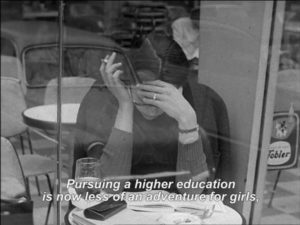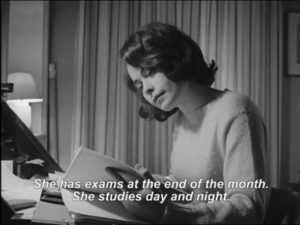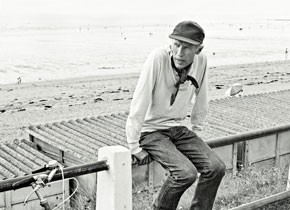I am fascinated by the 1950-60’s culture — everything about it, from the way they dressed, the hairstyles, the dancing, even their furniture. Compared to the sweatpants and hoodies commonly worn today among college students, French college students carried themselves with elegance in their clothing and everyday lives. Not to say that modern college students don’t pride themselves in their athleisure and appearances, but it’s hard to deny that we have lost a little bit of that flair. Eric Rohmer’s 1966 documentary, Une étudiante d’aujourd’ hui or more commonly known as A Modern Coed, follows the everyday life of women in college. At just 18-minutes, this short film documentary has just enough time to explain how women changed the college scene to A Modern Coed.
The 1960’s harbored the beginning of the second wave of feminism, but I tend to use feminism as an umbrella term, because it can mean multiple things varying on the individual. In general, the foundation of feminism lies in the idea that women should be treated equally to men in society. Again, I can’t speak for all feminists, but many female-identifying individuals don’t want to be given special treatment just because they’re women; they want to be held to the same expectations given to men. For instance, the pay gap is a popularly debated topic, dealing with the wage difference between men and women while doing the same job. Or, the Pink Tax, which is price discrimination based on gender, since female products (or pink products) seem to be priced higher than those geared toward males. I personally see this happen most commonly with beauty products. You could see the same shaving razor on a store’s shelf, but one could be colored pink and marketed for women, and it would be at least two bucks more.
Another example is the “glass ceiling”, a metaphor for how the “glass ceiling” keeps females from moving upwards in their profession, even though there might be some form of gender equality in the workplace. On the other hand, there is a metaphor called the “glass escalator”, which represents factors that escalate males in their workplace, usually in a female-dominated career. One last example is that women were not allowed to vote until 1920 when the 19th amendment was passed. All of these exceptions are solely based on the difference of gender; if that doesn’t sound crazy to you, then go ahead and label ME nuts. At least in Rohmer’s documentary, he respectfully cheers the female gender on from the sidelines by adding witty dialogue combating stereotypes about women in college.
The film starts with short clips of college women walking around the busy streets of Paris; it is in these beginning shots we get a glimpse of what their fashion was like. There are also clips of them studying at café’s or reading the newspaper. Sure, we have cafés here to drink coffee and type our essays out on our computers, but nothing can compare to the crisp Parisian air while sitting on a sidewalk and sipping an espresso. The short clips also showed that many students didn’t carry backpacks with them; instead, they held their textbooks and notebooks in their arms with cute, tiny purses to complete their look.

A random college student doing homework at a café.
While showing us the average female student, the narrator (Antoine Vitez) starts to talk about how many females enrolled in college, telling viewers that about 43% of all college students were female in Paris universities during the late 1960s. The narrator talks about where many college students lived, their majors, and their everyday academic schedule. There isn’t any specific point that sticks out above the rest in the narration, but the film’s shots portray what colleges looked like from the study areas, to the lunchroom and the courtyards where there would be groups playing volleyball, or studying in the shade. The college campus was clean and very modern looking. Even though the narrator talks about the broader spectrum of women in college, we also follow a specific girl throughout the film, but her name isn’t given in the film and I couldn’t find it while researching for the life of me.

The main, unnamed girl studying.
About two-thirds of the way through, the narrator discusses the love life of a female in college, saying that there was an assumption that women only went to college to snatch up a husband, but Rohmer immediately shuts that down by saying, “Though today’s coed might find a husband, she isn’t necessarily looking” (A Modern Coed). He also talks about how women understand that their education and responsibilities give them strength, even with free time on-hand and without a husband. By the end of the film, we see that the couple does end up together and has a baby, but she is still just as happy and can easily control the balance between her family and school.
The best thing about this documentary is that Rohmer truly seems educated. He didn’t just film women in college, finding out and filming fundamental aspects of their life. He used this as a transition into the modern world where females and males could be seen equally in the academic setting. Since then, there have been significant steps towards ending gender discrimination. Cases like Reed vs. Reed that Ruth Bader Ginsburg fought for doesn’t just mean gender discrimination can happen to a female; it can happen to males as well. We need to work past using gender as a determination of who a person is and represents… But, that’s a much longer chat than I can offer through this review.
In terms of placing this film among the other French New Wave films we’ve discussed, this short documentary fits right in with the existential feeling that other New Wave films created. Nobody dies or has a fear of death, but the film examines life as it is lived. The movement has always highlighted a want for something greater, and the French New Wave directors saw that want and how that want was represented in their own lives. In Rohmer’s case, there was nothing lovelier than seeing others live their life as if nobody was watching, despite most of the film showing the students with their heads down. writing notes or reading a book. Even then, college is just another part of life. Rohmer has made a sizable stride in female representation with such a small and short film, proving that it doesn’t take much to portray the life of an everyday modern coed accurately.


Recent Comments